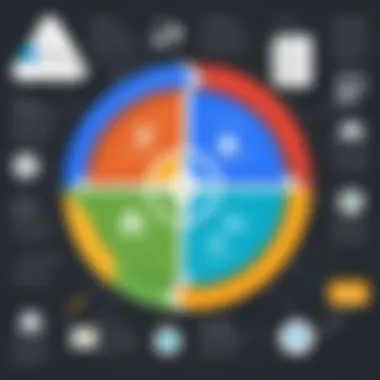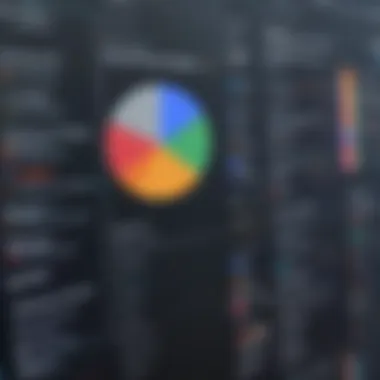Google Play's Role in Shaping Consumer Technology


Intro
Google Play has evolved into a cornerstone of consumer technology in the modern digital age. As a hub for numerous applications, it significantly influences how users interact with their devices. Understanding Google Play's structure and functionality is essential for anyone engaged with technology. This article will dissect its role, its impact on consumer behavior, and emerging trends developers need to consider.
Overview of the Technology
Google Play serves as the primary distribution platform for Android applications. It not only provides a space for developers to publish their apps but also acts as a marketplace for users seeking software to enhance their experience.
Key Specifications
- Operating System Compatibility: Primarily designed for Android OS, but some functionalities extend to other devices, enhancing its reach.
- User Base: As of October 2023, there are over 2.5 billion active Android devices, showcasing the extensive user base accessible via Google Play.
- App Variety: The platform hosts millions of applications spanning various categories like productivity, entertainment, education, and gaming.
Unique Selling Points
Google Play distinguishes itself from other app stores through several unique features:
- Integration with Google Services: Seamless access to Google services such as Google Maps, Google Drive, and Google Assistant enhances user experience.
- Personalization: Utilizing user data, the platform provides recommendations tailored to individual preferences, making it easier to discover apps relevant to each user.
- Security Measures: Google Play incorporates robust security protocols to protect users from malicious apps, creating a trustful environment which is critical for consumer confidence in app downloads.
Design and Build Quality
The design of Google Play reflects a focus on usability and efficiency. The user interface is intuitive, catering to a wide range of tech-savviness among users.
Material Used
While Google Play itself does not consist of physical materials, the platform benefits from the software structure designed to provide a responsive and agile user experience.
Ergonomics and Usability
- User Interface Design: Streamlined and engaging, the layout allows for easy navigation, facilitating a hassle-free search for desired applications.
- Accessibility Features: The platform prioritizes accessibility, ensuring individuals with disabilities can utilize its offerings without barriers.
"Google Play plays a profound role in shaping consumer technology by modifying the way people consume digital content and software."
Ending
Understanding Google Play's contributions to consumer technology helps to appreciate its significance. From offering diverse applications to ensuring user safety, it is clear that this platform is fundamental in today's tech-driven world. This overview lays the foundation for further discussions on its impact on consumer behavior, emerging trends, and the overall app ecosystem.
Intro to Google Play
In recent years, Google Play has emerged as a critical platform within the consumer technology landscape, fundamentally altering how users access and experience mobile applications. Understanding its role is imperative for both users and developers alike. Google Play is not merely a marketplace; it is a complex ecosystem that facilitates the distribution and management of apps, offers various services, and shapes consumer behavior through its features.
The significance of Google Play lies in its vast library of applications, which spans numerous categories including productivity, entertainment, education, and gaming. With millions of apps available, the platform serves as a one-stop destination for users seeking innovative solutions and entertainment options. This accessibility empowers consumers to explore and utilize a diverse range of tools designed to enhance their everyday lives.
For developers, Google Play provides a vital avenue for reaching global audiences. They benefit from the platform's established infrastructure, which simplifies the process of publishing and maintaining applications. Additionally, it also offers multiple monetization strategies, enabling developers to generate revenue effectively.
In terms of user experience, Google Play is continually evolving. It integrates user feedback, app ratings, and tailored recommendations to assist consumers in making informed choices. As such, navigating Google Play can significantly influence purchasing decisions, resulting in a direct impact on a developer's success.
Moreover, the system's emphasis on security and privacy fosters a safer environment for consumers. This trust is crucial, particularly as concerns about data privacy become more prevalent.
Overall, the introduction of Google Play highlights its multifaceted benefits and the critical role it plays in the modern technology ecosystem. By examining its various dimensions, both consumers and developers can better understand how to leverage this platform to meet their needs.
The Evolution of Google Play
The evolution of Google Play reflects profound changes in consumer technology and app ecosystems. As a central hub for digital content, Google Play has transformed not just how apps are distributed but how they interact with users and drive consumer behavior. Understanding its evolution is critical to grasping its significance in today’s tech landscape. The platform has established itself as a cornerstone of the Android experience, influencing both developers and users through its numerous features and updates.
History and Development


Google Play originated from Android Market, which launched in 2008. Initially, it served as a marketplace for Android applications and provided a limited array of content, focusing mainly on apps and games. This initial phase was characterized by a lack of organization and user engagement features. The introduction of music and ebooks in 2011 marked a significant shift. By consolidating various content types under one umbrella, Google aimed to enhance the user experience and accessibility of digital media.
In 2012, the rebranding to Google Play symbolized a new era. This was not merely cosmetic; it also reflected the initiative's goal to create a unified platform for all entertainment and app needs. As smartphones and tablets gained popularity, Google Play expanded its offerings further. Thus, it played a vital role in promoting mobile applications and making them more available to a broader audience.
Major Updates Over the Years
Over the years, Google Play has undergone numerous updates that have significantly improved its functionality. These updates often included enhancements to the user interface, making navigation more intuitive. Features like the Play Store's algorithm for app recommendations emerged, tailored to user preferences. In 2015, Google introduced the 'Family Library' feature, allowing multiple users to share content seamlessly. Such developments have not only aided user interaction but also encouraged family engagement with digital content, emphasizing the platform's role in daily life.
Furthermore, with the rise of subscriptions, Google Play adapted to industry trends by allowing developers to offer various billing options. This flexibility has encouraged innovation in app monetization strategies. In response to growing privacy concerns, updates have also focused on enhancing security features. Users can now find more transparency regarding app permissions and privacy practices.
"The multi-faceted evolution of Google Play demonstrates its commitment to fostering an engaging and trustworthy environment for developers and consumers alike."
Each update has contributed to a more cohesive and user-friendly system, establishing Google Play as an essential part of consumer technology today. The ongoing evolution suggests that the platform will continue to adapt to the changing landscape of digital consumption.
Key Features of Google Play Now
Google Play serves as a vital platform in the contemporary consumer technology landscape. Its key features shape not only user engagement but also the operational framework for app developers. Understanding these elements is essential for appreciating their impact on the app ecosystem and consumer behavior.
User Interface and Experience
The user interface (UI) of Google Play is designed with simplicity and accessibility in mind. When users access the platform, they expect a fast and intuitive experience. This ease of navigation is crucial, as it encourages frequent interactions and reduces barriers to discovering new apps.
For example, users can effortlessly browse through applications, games, and digital content due to well-organized categories and filters. The search functionality allows for quick retrieval of specific apps tailored to user needs. More importantly, the Google Play Store employs a user-centric design, emphasizing visual elements and straightforward layouts, which fosters a more engaging environment.
App Distribution and Management
Google Play is the primary distribution channel for Android apps. Developers rely on this platform for reaching a wide audience. The management tools provided enable developers to keep control over updates and user feedback. This level of oversight is essential for keeping apps relevant and ensuring user satisfaction.
Apps are uploaded through the Google Play Console, which offers features for tracking downloads and user engagement. Developers can also utilize insights from analytics to adjust their strategies. In this aspect, Google Play’s role as a mediator between developers and consumers enhances the overall quality and performance of apps offered.
In-App Purchases and Monetization
Monetization strategies in the Google Play ecosystem are diverse, offering developers various paths to revenue. In-app purchases are especially prominent, allowing users to buy additional features or content directly within applications. This method aligns with changing consumer behavior, where users prefer flexibility in spending.
Alongside in-app purchases, Google Play accommodates subscription models. Many apps have adopted this approach to create recurring revenue streams. Such models require careful consideration from developers in terms of pricing and content offerings to maintain user interest. Understanding monetization without alienating users is key in this competitive environment.
"Google Play's monetization options empower developers to tailor their revenue models to fit their audience's desires, enhancing both profit margins and user satisfaction."
In summary, the key features of Google Play exemplify its importance in consumer technology. The user interface prioritizes ease of access, while app distribution and management tools support developers in optimizing their offerings. Lastly, diverse monetization strategies facilitate revenue generation, accommodating evolving user expectations.
Impact on App Developers
The influence of Google Play on app developers cannot be overstated. The platform serves as a crucial gateway for developers to reach millions of users across the globe. With its vast user base and comprehensive app distribution system, it offers a wealth of opportunities and challenges. This section examines how Google Play affects those creating apps and the dynamics they must navigate in this digital ecosystem.
Growth Opportunities
Google Play offers numerous growth opportunities for app developers. Firstly, the sheer size of the Android user base is advantageous. With billions of active devices, developers have an extensive pool of potential customers. This ensures that successful apps can reach substantial market penetration.
Moreover, Google Play’s built-in tools for app visibility enhance discoverability. Features like Top Charts, Editor’s Choice, and tailored recommendations can significantly boost an app’s exposure. Developers can also utilize Google’s Play Console for insights and analytics, allowing them to optimize their app strategically.
Additionally, the flexibility of Google Play’s monetization options offers developers various paths to revenue. They can choose from in-app purchases, subscriptions, and advertisement placements, catering to different consumer preferences.
Developers often benefit from participating in the Google Play Beta Program. This allows them to test new features and get early feedback, improving the final product before widespread release. It creates a constant cycle of innovation and refinement, essential in today’s fast-paced tech landscape.
"The app ecosystem is continuously evolving, and developers must adapt to stay relevant."
Challenges Faced by Developers


Despite the opportunities, developers encounter significant challenges on Google Play. One major issue is intense competition. With millions of apps available, standing out becomes a daunting task. Many developers struggle to gain visibility in a saturated market.
Another challenge is navigating the frequent policy changes and guidelines enforced by Google. Non-compliance can lead to apps being removed or suspended, causing revenue loss. Staying up to date on these policies is crucial for developers, but it can be resource-intensive.
Technical challenges also arise, particularly with keeping apps compatible with various Android versions and devices. The fragmentation of the Android ecosystem can complicate the development process. Developers must ensure consistent performance across different hardware, which demands thorough testing and quality assurance.
Finally, maintaining user trust is vital but often difficult. With increasing scrutiny on data privacy and security, developers must prioritize user information protection. Failing to do so can lead to reputational damage and loss of users, impacting an app’s success in the market.
The Role of Google Play in Consumer Behavior
The significance of Google Play within consumer behavior cannot be overstated. As the primary distribution platform for Android applications, it shapes how consumers discover and interact with apps. Google Play not only serves as a marketplace but also influences purchasing habits through various mechanisms. Understanding this role is crucial for both consumers and developers alike.
Influencing Purchasing Decisions
Consumer decisions are largely influenced by what is available on Google Play. The vast array of applications allows users to choose from entertainment, utilities, productivity, and more. When a user searches for an app, they often rely on the visibility and ranking of available options. Apps that appear on the front page or are marked as "Featured" tend to gain more attention, leading to higher download rates.
Several factors play into these decisions:
- Promotions and Discounts: Apps that offer limited time discounts can prompt impulse purchases, swaying consumers.
- Personalized Recommendations: Google Play uses algorithms to recommend apps based on user preferences and past behavior, directly impacting choices.
- Advertising: App developers invest in advertisements that appear within the Google Play Store itself, capturing user interest when browsing.
- Brand Recognition: Established brands often see a mixed reception; users are usually inclined to opt for well-known apps, assuming reliability and quality.
It is vital for developers to recognize these elements to appeal better to target audiences. They must strategize on how to market their applications effectively within this ecosystem.
User Reviews and Ratings
User reviews and ratings are crucial in guiding purchasing decisions. Consumers frequently consult these assessments before downloading applications. The presence of positive reviews and high ratings builds trust. Conversely, a low rating or negative feedback can deter potential users.
Factors that make reviews significant include:
- Credibility: Users often perceive reviews as authentic, which enhances trust in the app’s performance.
- Feedback Loop: Reviews provide developers with insights into user experiences. This feedback loop enables continuous improvement of their products.
- Social Proof: A higher number of positive reviews serves as social proof, influencing new consumers to join the user base.
To maximize their own presence, developers should encourage satisfied users to leave favorable feedback. This move improves their app’s visibility and attractiveness.
"In the world of online consumer behavior, reviews often function as the deciding factor in whether a purchase is made or not."
In summary, Google Play plays a vital role in shaping consumer behavior by influencing purchasing decisions and promoting the importance of user reviews and ratings. Understanding these dynamics is key for developers aiming to establish a successful foothold in the app marketplace.
Current Trends in Google Play
Understanding current trends in Google Play is essential for both users and developers. This section delves into the shifts happening on the platform, which directly affect consumer behavior and the app ecosystem. Recognizing these trends helps users make informed decisions and allows developers to adapt their strategies accordingly.
Rise of Subscription Models
As the digital landscape evolves, subscription models are becoming more prevalent in Google Play. Instead of a one-time purchase, many apps now offer subscriptions for access to premium features. This shift benefits consumers by providing continuous updates and support rather than a static product. Consumers appreciate the flexibility that subscriptions offer, as they can opt for monthly or yearly plans based on their needs.
For developers, this trend opens new revenue streams. By offering subscriptions, developers can create sustainable business models that ensure recurring income. Are there drawbacks? Yes, consumers must remain vigilant about how many subscriptions they take on.
Focus on Security and Privacy
In an era where data breaches are increasingly common, security and privacy have become paramount for users. Google Play is responding by implementing more stringent security measures. This includes better tracking of app permissions and more rigorous guidelines for developers to ensure the safety of user data.
"The concern for privacy is reshaping the app market; users now prioritize trustworthy applications, affecting which apps they download."
For consumers, this means enhanced security but also a need for constant awareness about app permissions. Developers must prioritize transparency and user education regarding data handling to build trust.
Integration with Other Google Services


The integration of Google Play with other Google services is significant for creating a seamless user experience. Services like Google Assistant and Google Drive are linked with Google Play, enabling functionalities that improve usability. For instance, users can easily save their game progress directly to Google Drive or use voice commands to open apps.
This interconnected ecosystem enhances the value of apps on Google Play. Consumers benefit from a cohesive environment that simplifies their digital experiences. Developers can leverage this integration to expand their app functionalities, thus attracting more users who appreciate a well-integrated service.
Best Practices for Consumers
Understanding best practices for consumers using Google Play is crucial for maximizing the experience with the platform. With the vast selection of applications available, it is essential to navigate wisely to reap the full benefits. Employing effective strategies can lead to enhanced app performance, efficient resource management, and overall satisfaction.
Optimizing App Usage
To make the most of Google Play, consumers should consider several tactics for optimizing app usage. First, it is important to be selective when downloading applications. Look for apps that have been positively reviewed and are frequently updated. This not only ensures a better user experience but also minimizes security risks. Users should also regularly review the apps they have installed. Removing apps that are no longer used can free up storage space and improve device performance.
Another key aspect is to manage app permissions. Users should be aware of what information and features they are allowing apps to access. This can protect privacy and prevent unwanted data sharing.
Lastly, leveraging in-app features can provide additional benefits. For example, utilizing built-in settings can enhance personalization and utility according to user preferences.
Managing Subscriptions Effectively
In recent years, subscription models have become prevalent in mobile applications. Managing these subscriptions effectively is vital to avoid unnecessary expenses. One of the first steps consumers can take is to review their subscription options regularly. Google Play provides a clear summary of all active subscriptions. This allows users to assess whether an ongoing subscription remains valuable.
Setting reminders for subscription renewals can aid in decision-making. Consumers should ensure they know when a subscription is set to renew, giving them the option to cancel if needed. Furthermore, opt for annual plans where feasible. These often come with cost savings compared to monthly payments, delivering better long-term value.
"Effective management of subscriptions can enhance user experience and reduce financial strain."
Additionally, always read the terms and conditions associated with each subscription. Understanding cancellation policies and renewal terms helps prevent unexpected charges. Following these practices allows consumers to enjoy the benefits of Google Play while maintaining financial control.
Future Outlook for Google Play
The future outlook for Google Play is crucial to understanding how this platform will evolve in the fast-paced world of consumer technology. As we dive into the potential developments and challenges ahead, it becomes clear that Google Play is not just a distribution service; it is a central hub shaping user experiences and developer opportunities. By examining the predicted developments, we can anticipate changes that may redefine how apps are discovered and used. Additionally, analyzing potential challenges helps stakeholders prepare for what lies ahead, ensuring that both consumers and developers can navigate the shifting landscape effectively.
Predicted Developments
As technology continues to progress, several trends are likely to influence the evolution of Google Play. Key predicted developments include:
- Enhanced User Experience: Future updates may focus on improving user interfaces and experience. Google may introduce more personalized app recommendations based on user behavior, which would greatly enhance discoverability.
- Emergence of AI-driven Features: Artificial intelligence is expected to be integrated deeper within Google Play. This may include smarter search algorithms that understand user intentions better and suggest apps that align with their needs.
- More Diverse Monetization Models: The landscape of app monetization is likely to evolve. Developers may shift towards more innovative models such as pay-per-use, rather than just reliance on subscriptions or one-time purchases.
- Increased Focus on Accessibility: As accessibility becomes a priority, Google Play is expected to improve features that ensure apps cater to a broader range of disabilities. This inclusivity will likely widen the user base and enrich the app ecosystem.
Furthermore, the integration of augmented reality and virtual reality features in apps may redefine how users interact with technology. These developments suggest that Google Play will not only adapt but also lead trends in the consumer technology landscape.
Potential Challenges Ahead
Despite the exciting prospects, there are unavoidable challenges. Developers and consumers may encounter obstacles such as:
- Market Saturation: As the number of available apps grows, standing out becomes increasingly difficult. This can dilute consumer attention and increase competition.
- Regulatory Hurdles: Increased scrutiny from governments regarding data privacy and app store policies may pose risks for developers. Compliance with changing regulations can add significant operational overhead.
- Security Concerns: With rising concerns around security, the onus is on Google to ensure that its platform is safe. Users expect robust security measures, and failing to deliver could damage trust.
- Adapting to Consumer Preferences: Consumer preferences are fickle. Keeping pace with how users interact with technology is essential for any future development. Google Play must continuously innovate to keep users engaged.
In summary, while the future of Google Play holds promise, it is also filled with hurdles that must be navigated carefully. By being aware of both the potential developments and challenges, stakeholders can better prepare for the evolving landscape of consumer technology.
Culmination: The Importance of Google Play
Google Play is more than just an app store; it is a comprehensive ecosystem that influences the way consumers interact with technology. The platform plays a crucial role in disseminating apps, games, and digital content. Its impact extends to how developers create and manage their products. The dynamics found within Google Play shape the consumer experience in various ways.
Through Google Play, users gain access to an array of applications that enhance productivity, entertainment, and lifestyle. The user interface eases navigation, promoting a seamless experience for downloading and utilizing software. This accessibility fosters user engagement, encouraging exploration of diverse apps while establishing loyalty to the platform.
Moreover, Google Play facilitates a revenue model that benefits developers while meeting consumer demands. The in-app purchase system provides developers with flexibility to monetize applications effectively. This encourages innovation and promotes the development of high-quality content. When users support these monetization strategies, they contribute to an ongoing cycle of investment back into the app ecosystem.
Notably, Google Play is also a vital conduit for security updates and privacy measures. As consumers become more concerned about digital safety, the platform's focus on these areas enhances user trust. This assurance impacts consumer behavior significantly, making it essential for app developers to prioritize security features in their applications.
"The integration of diverse services within Google Play streamlines the user experience while optimizing the app ecosystem for developers."
In terms of market trends, Google Play stands at the forefront of innovation. The rise of subscription models and a push for enhanced security measures reflect consumer needs while also anticipating future technology landscapes. This adaptability highlights Google Play's relevance and its ongoing significance in consumer technology.
To summarize, Google Play is fundamental in shaping the app ecosystem. It influences purchasing decisions through effective marketing strategies, user feedback, and the overall quality of available apps. For developers and users alike, understanding Google Play's role is critical for navigating the complexities of modern technology. Its continual evolution offers a glimpse into future trends, making it an indispensable part of the consumer technology narrative.







